Equations Of Motion
Motion under uniform acceleration
1st Equation of motion
For an object moving with uniform velocity, v, its displacement, s after time, t is given by:
s = v × t
Consider a body having initial velocity ‘u’. Suppose it is subjected to a uniform acceleration ‘a’ so that after time ‘t’ its final velocity becomes ‘v’. Now we know,
\( \text{ }\!\!~\!\!\text{ Acceleration}=\frac{\text{change}\,\,\text{in}\,\text{velocity}}{\text{Time}} \)
\( a=\frac{v-u}{t} \)
or v = u + at …..(i)
2nd Equation of motion
Suppose a body has an initial velocity ‘u’ and uniform acceleration ‘a’ for time ‘t’ so that its final velocity becomes ‘v’. The distance travelled by moving body in time ‘t’ is ‘s’ then the average velocity = (v + u)/2.
Distance travelled = Average velocity × time
\( \text{S}=\left( \frac{u+v}{2} \right)t\text{ } \)
\( \Rightarrow \text{S}=\left( \frac{u+u+at}{2} \right)t\text{ }\left( as\text{ }v=u+at \right)~ \)
\( \Rightarrow \text{S}=\left( \frac{2u+at}{2} \right)t \)
\( \Rightarrow \text{S}=\frac{2ut+a{{t}^{2}}}{2} \)
\( \text{S}=ut+\frac{1}{2}a{{t}^{2}}\text{ }……\text{ (ii)} \)
3rd Equation of motion
Distance travelled = Average velocity x time
\( S=\left( \frac{u+v}{2} \right)t\text{ }………\text{ (iii)} \)
\( \text{from equation }\left( \text{i} \right)\text{ }t=\frac{v-u}{a} \)
Substituting the value of t in equation (iii),
\( \text{we get }S=\left( \frac{v-u}{a} \right)\left( \frac{v+u}{2} \right) \)
\( S=\left( \frac{{{v}^{2}}-{{u}^{2}}}{2a} \right) \)
⇒ 2as = v2 – u2 or
v2 = u2 + 2as ….(iv)
The equations of motion under gravity can be obtained by replacing acceleration by acceleration due to gravity (g) and can be written as follows
- When the body is coming towards the centre of earth
(a) v = u + gt (b) h = ut + \(\frac { 1 }{ 2 }\) gt2 (c) v2 = u2 + 2gh - When a body is thrown upwards with some initial velocity, then a retardation produced due to attraction of the earth. In equations of motion, a is replaced by (–g) and thus equations become.
(a) v = u – gt (b) h = ut – \(\frac { 1 }{ 2 }\) gt2 (c) v2 = u2 – 2gh
Body Falling Freely Under Gravity
Assuming u = 0 for a freely falling body
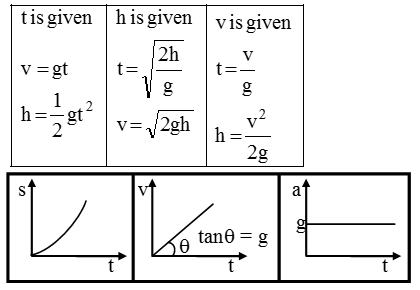
Body is projected vertically up:
Taking initial position as origin and direction of motion (i.e. vertically up) as positive.
(a) At the highest point v = 0
(b) a = – g
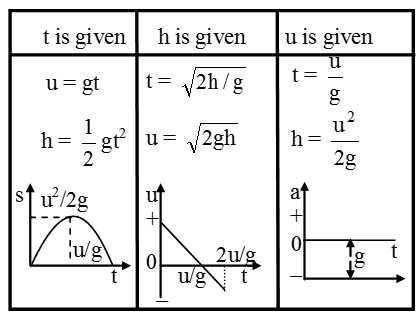
It is clear that in case of motion under gravity
(a) Time taken to go up is equal to the time taken to fall down through the same distance.
(b) The speed with which a body is projected up is equal to the speed with which it comes back to the point of projection.
(c) The body returns to the starting point with the same speed with which it was thrown.
Equations Of Motion Example Problems With Solutions
Example 1. A car is travelling with a uniform velocity of 80 km h-1 northward from Johor Bahru.
What is its displacement after 15 minutes?
Solution:
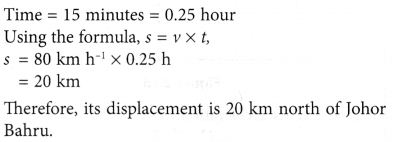
Example 2. A train travelling in a straight line at 30 ms-1accelerates uniformly to 54 ms-1 in 3.0 seconds. Calculate the distance travelled by the train during that time.
Solution:

Example 3. A school bus accelerates with an acceleration of 4.0 m s-2 after picking up some students at a bus stop.

Calculate the
(a) velocity of the bus after 5 s.
(b) distance travelled by the bus after 5 s.
Solution:
Initial velocity, u = 0 ms-1
Acceleration, a = 4.0 ms-2
Time, t = 5 s
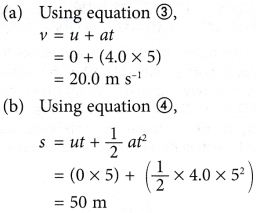
Example 4. A long jumper was running at a velocity of 5 m s-1 towards the long jump pit. He needed to achieve a velocity of 10 m s-1 after covering a distance of 4.5 m before lifting himself off the ground from the jumping board.
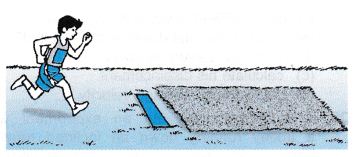
(a) Calculate the required acceleration for him to do so.
(b) Calculate the time taken for him to cover the horizontal distance of 4.5 m.
Solution:
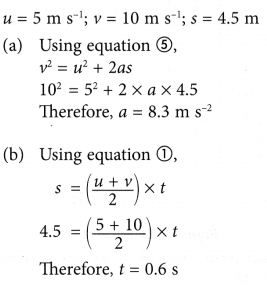
Example 5. 10 A body starts moving with an initial velocity 50 m/s and acceleration 20 m/s2. How much distance it will cover in 4s ? Also, calculate its average speed during this time interval.
Solution: Given: u = 50 m/s, a = 20 m/s2, t = 4s, s = ?
s = ut + \(\frac { 1 }{ 2 }\) at2 = 50 × 4 + \(\frac { 1 }{ 2 }\) × 20 × (4)2
= 200 + 160 = 360 m
Average speed during this interval,
\(\overline{V}=\frac{\text{distance travelled}}{\text{time interval}}=\frac{360}{4}=90\text{ m/s}\)
Example 6. A body is moving with a speed of 20 m/s. When certain force is applied, an acceleration of 4 m/s2 is produced. After how much time its velocity will be 80 m/s ?
Solution: Given: u = 20 m/s, a = 4 m/s2, v = 80 m/s, t = ?
Using equation, v = u + at, we get
80 = 20 + 4 × t
or 4t = 80 – 20 = 60
or t = 15 s
Therefore, after 15 seconds, the velocity of the body will be 80 m/s.
Example 7. A body starts from rest and moves with a constant acceleration. It travels a distance s1 in first 10 s, and a distance s2 in next 10 s. Find the relation between s2 and s1.
Solution: Given : u = 0, t1 = 10 s
∴ Distance travelled in first 10 seconds, is given by
s1 = ut + \(\frac { 1 }{ 2 }\) at2 = 0 + \(\frac { 1 }{ 2 }\) × a × (10)2
s1 = 50a …(1)
To calculate the distance travelled in next 10s, we first calculate distance travelled in 20 s and then subtract distance travelled in first 10 s.
s = ut + \(\frac { 1 }{ 2 }\) at2 = 0 + \(\frac { 1 }{ 2 }\) × a × (20)2
s = 200a …(2)
∴ Distance travelled in 10th second interval,
s2 = s – s1 = 200a – 50a …(3)
or s2 = 150a
\(\text{Now, }\frac{{{s}_{2}}}{{{s}_{1}}}=\frac{150a}{50a}=\frac{3}{1}\)
or s2 = 3s1
Example 8. A train is moving with a velocity 400 m/s. With the application of brakes a retardation of 10 m/s2 is produced. Calculate the following
(i) After how much time it will stop ?
(ii) How much distance will it travel before it stops ?
Solution: (i) Given: u = 400 m/s, a = –10 m/s2, v = 0, t = ?
Using equation, v = u + at, we get
0 = 400 + (–10) × t
or t = 40 s
(ii) For calculating the distance travelled, we use equation,
v2 = u2 + 2as, we get
(0)2 = (400)2 + 2 × (–10) × s
or 20s = 400 × 400
or s = 8000 m = 8 km
Example 9. A body is thrown vertically upwards with an initial velocity of 19.6 m/s. If g = –9.8 m/s2. Calculate the following
(i) The maximum height attained by the body.
(ii) After how much time will it come back to the ground ?
Solution: (i) Given: u = 19.6 m/s, g = –9.8 m/s2, v = 0, h = ?
Using equation v2 = u2 + 2gh, we get
(0)2 = (19.6)2 + 2(–9.8) × h
\(h=\frac{19.6\times 19.6}{2\times 9.8}=19.6\text{ m}\)
(ii) Time taken to reach the maximum height can be calculated by the equation,
v = u + gt
0 = 19.6 + (–9.8) × t
t = 2s
In the same time, it will come back to its original position.
∴ Total time = 2 × 2 = 4s
Example 10. From the top of a tower of height 490 m, a shell is fired horizontally with a velocity 100 m/s. At what distance from the bottom of the tower, the shell will hit the ground ?
Solution: We know that the horizontal motion and the vertical motion are independent of each other. Now for vertical motion, we have u = 0,
h = 490 m, g = 9.8 m/s2, t = ?
Using equation, h = ut + \(\frac { 1 }{ 2 }\) gt2, we get
490 = 0 + \(\frac { 1 }{ 2 }\) × 9.8 × t2
or t2 = \(\frac { 490 }{ 4.9 }\) = 100
or t = 10 s
∴ It takes 10 seconds to reach the ground.
Now, horizontal distance = horizontal velocity × time
= 100 m/s × 10 s = 1000 m
∴ The shell will strike the ground at a distance of 100 m from the bottom of the tower.